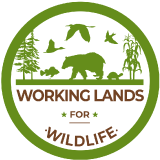-
 ANCHOR: An Opportunity to Change Landscape Connectivity Networks and Conservation Delivery At-Scale in the U.S.
ANCHOR: An Opportunity to Change Landscape Connectivity Networks and Conservation Delivery At-Scale in the U.S.
-
by
Rosanne Hessmiller
—
published
Feb 23, 2025
—
last modified
May 10, 2025 04:38 PM
—
filed under:
Connectivity,
Omniscape,
Northern Bobwhite Quail,
Areawide Network,
Large Landscape,
Circuit Theory,
Native Grasslands,
ANCHOR
Abstract: Connectivity modeling has been a tool available to the conservation community
since the 1980s that guides our responses to habitat fragmentation. While the sophistication
of computer modeling continues to grow, on-the-ground delivery remains challenging and
lacks urgency. We present an approach to scale up delivery and do so within effective
timeframes. The approach, termed ANCHOR (Areawide Networks to Connect Habitat and
Optimize Resiliency), is grounded in connectivity science but executed in a manner that
is flexible, expandable, and measurable. ANCHOR goes beyond the traditional protected
area focus for establishing connected biomes to maximize the contributions of existing
public lands and expand private landowner participation. The approach is applied using
an umbrella species to represent a faunal group and/or multiple taxa to deliver co-benefits
of landscape connectivity. Public lands receive connectivity rankings that are then used to
engage potential connectivity partners who commit land units and collectively monitor
improvements in habitat quality and landscape resiliency. The ANCHOR approach can
guide unprecedented participation across agencies and departments to create public lands
networks, while private and corporate lands establish landscape connections. To illustrate
the approach, we present an example of native grasslands conservation in the central and
eastern U.S. and an emerging partnership with the Department of Defense.
Located in
ANCHOR Resources
-
Northern Bobwhites and Fire: A Perfect Match
-
by
Rhishja Cota
—
published
Dec 30, 2020
—
last modified
Apr 05, 2022 09:12 PM
—
filed under:
Wildland Fire,
Northern Bobwhite Quail
Prescribed fire, bobwhite ecology, and local site conditions need to be aligned for optimal bobwhite population response. This course discusses the context of fire frequency, scale, and seasonality for bobwhite management and restoration.
Located in
Resources
/
Upload New Resources
-
 Prescribed Fire
Prescribed Fire
-
by
Web Editor
—
published
Aug 27, 2019
—
filed under:
Prescribed fire,
Northern Bobwhite Quail,
Gopher Tortoise
Prescribed burns used to manage habitat for bobwhite, gopher tortoise.
Located in
Resources
/
Images
-
 Prescribed Burn-Here It Comes!
Prescribed Burn-Here It Comes!
-
by
Web Editor
—
published
Aug 27, 2019
—
filed under:
Prescribed fire,
Northern Bobwhite Quail,
Gopher Tortoise
Prescribed burns used to manage habitat for bobwhite, gopher tortoise.
Located in
Resources
/
Images
-
 Attack One Burn Crew Georgia 2018
Attack One Burn Crew Georgia 2018
-
by
Web Editor
—
published
Aug 27, 2019
—
last modified
Aug 27, 2019 09:05 PM
—
filed under:
Fire,
Prescribed fire,
Northern Bobwhite Quail,
Gopher Tortoise
Prescribed burns used to manage habitat for bobwhite, gopher tortoise.
Located in
Resources
/
Images
-
 Landowner Before Site Burn Florida
Landowner Before Site Burn Florida
-
by
Web Editor
—
published
Aug 27, 2019
—
filed under:
Northern Bobwhite Quail,
Gopher Tortoise
Prescribed burns used to manage habitat for bobwhite, gopher tortoise.
Located in
Resources
/
Images
-
 Prescribed Burn Path
Prescribed Burn Path
-
by
Web Editor
—
published
Aug 27, 2019
—
filed under:
Prescribed fire,
Northern Bobwhite Quail,
Gopher Tortoise
Prescribed burns used to manage habitat for bobwhite, gopher tortoise.
Located in
Resources
/
Images
-
 North Carolina Wildlife Resources Commission
North Carolina Wildlife Resources Commission
-
by
Matthew Cimitile
—
published
Dec 12, 2012
—
last modified
May 30, 2024 08:12 PM
—
filed under:
WLFW,
American Black Duck,
Bog Turtle,
Northern Bobwhite Quail,
North Carolina,
State,
State Agencies,
Eastern Hellbender
The North Carolina Wildlife Resources Commission is the state government agency that sustains the state’s fish and wildlife resources through research, scientific management, wise use, and public input. The Commission is the regulatory agency responsible for the enforcement of the state's fishing, hunting, trapping, and boating laws.
Located in
LP Members
/
Organizations Search
-
 Association of Fish and Wildlife Agencies
Association of Fish and Wildlife Agencies
-
by
Web Editor
—
published
Jun 04, 2019
—
last modified
Apr 21, 2023 12:39 AM
—
filed under:
Partners,
WLFW,
Federal,
Northern Bobwhite Quail,
Bobwhite,
State,
Regional Partnerships,
Grasslands and Savannas,
Working Lands for Wildlife
State, provincial, and territorial fish and wildlife agencies in North America have safeguarded fish and wildlife for over 100 years. The public entrusts these agencies with primary stewardship over vital wildlife resources. The Association of Fish and Wildlife Agencies lends collective voice to its agencies in fulfillment of that responsibility.
Located in
LP Members
/
Organizations Search
-
 USDA Natural Resources Conservation Service (NRCS)
USDA Natural Resources Conservation Service (NRCS)
-
by
Web Editor
—
published
Jun 04, 2019
—
last modified
Apr 16, 2024 03:18 PM
—
filed under:
Partners,
American Black Duck,
Farmers,
Federal,
Northern Bobwhite Quail,
Federal Agengies,
Grasslands and Savannas,
Eastern Hellbender,
Resources,
Eastern Deciduous Forests,
Bog Turtle,
American Black Duck Additional Resources,
Golden-Winged Warbler,
Working Lands for Wildlife,
Landowners,
WLFW,
USDA,
New England Cottontail,
Gopher Tortoise,
NRCS,
Aquatics,
Wildland Fire,
Additional Resources,
SE FireMap
NRCS helps America’s farmers, ranchers and forest landowners conserve the nation’s soil, water, air and other natural resources. All programs are voluntary and offer science-based solutions that benefit both the landowner and the environment.
Located in
LP Members
/
Organizations Search


